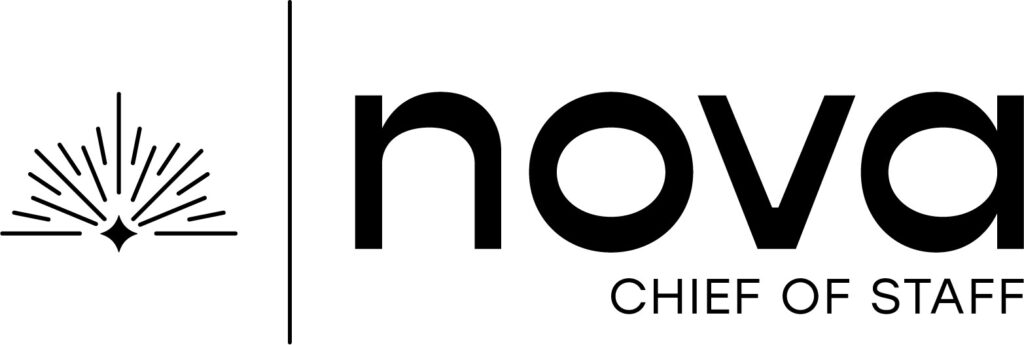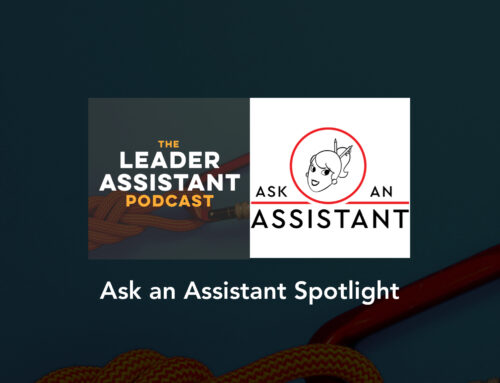Maggie Olson is the Founder of Nova Chief of Staff, the premier destination for Chief of Staff education and development.
In this episode of The Leader Assistant Podcast, Maggie talks about the journey from executive assistant to chief of staff, and how to level up in your role – no matter the title.
CONNECT WITH MAGGIE

ABOUT MAGGIE
Maggie Olson is the Founder of Nova Chief of Staff, the premier destination for Chief of Staff education and development. As the first Chief of Staff to a president at a Fortune 40 company — who led a multibillion-dollar business with 5,000+ employees — Maggie built the president’s Chief of Staff model from the ground up. Maggie has 20 years’ experience leading large teams and has spent her career focused on both customer and employee experience at companies including T-Mobile, Nordstrom, and Starbucks. In addition to operating the Nova Chief of Staff Certification course, Maggie is a fractional Chief of Staff focused on helping mission-driven, for-profit startup founders scale their businesses quickly. In her spare time, Maggie loves spending time outside with her husband, their animals, and their 1-year-old, Max!
–––
THE LEADER ASSISTANT PODCAST IS PRESENTED BY NOVA CHIEF OF STAFF
Calling all Executive Assistants: Are you looking for a way to elevate your skills or earn that promotion you’ve been eyeing? Nova Chief of Staff’s online certification course provides you with the knowledge and confidence you need to stand out on the job. Whether you want to land your dream position or level up in your current role, Nova’s self-paced course gives you hands-on practice doing what Chiefs of Staff do every day.
Visit leaderassistant.com/nova to learn more and secure your spot!
–––
THE LEADER ASSISTANT PREMIUM MEMBERSHIP
To learn more about how you can join growth-minded Leader Assistants, check out our Leader Assistant Premium Membership for ongoing training, coaching, and community.
THE LEADER ASSISTANT BOOK
Download the first 3 chapters of The Leader Assistant: Four Pillars of Game-Changing Assistant for FREE here or buy it on Amazon and listen to the audiobook on Audible. Also, check out the companion study guide, The Leader Assistant Workbook, to dig deeper.
LEADER ASSISTANT LIVE EVENTS
Check out our constantly updated schedule of events for admins and assistants at LeaderAssistantLive.com.
JOIN THE FREE COMMUNITY
Join the Leader Assistant Global Community for bonus content, job opportunities, and to network with other assistants who are committed to becoming leaders!
SUBSCRIBE
Subscribe to The Leader Assistant Podcast so you don’t miss new episodes!
You can find the show on Apple Podcasts, Spotify, Google Podcasts, Pandora, and Stitcher.
Join my email list here if you want to get an email when a new episode goes live.
LEAVE A REVIEW
If you’re enjoying the podcast, please take 2 minutes to rate and review the show on Apple Podcasts here. Each review helps me stay motivated to keep the show going!
—
EPISODE TRANSCRIPT
Jeremy Burrows [0:59 – 1:27]: Hey friends, welcome to the Leader Assistant podcast. It’s episode 257. This is your host, Jeremy Burrows. You can check out the show notes@leaderassistant.com 257leaders assistant.com 257 thank you so much for tuning in. And today is another fun conversation with my friend Maggie Olson from NOVA Chief of Staff. Maggie, welcome back.
Maggie Olson [1:28 – 1:29]: Thank you. Happy to be here.
Jeremy Burrows [1:29 – 3:14]: Yeah, we’re going to talk about the journey, the path, the transition from Executive Assistant to Chief of staff and how to level up if that is what you aspire to. And you know, we said this before in our conversations and we’ll say it again, I’m sure. But if you’re an executive assistant listening and you’re like, I really, really am excited about this opportunity to become a Chief of staff, this is for you. However, if you’re like me, who loves the executive assistant role, doesn’t necessarily aspire to be a Chief of staff or want that title necessarily like me, that’s how I am. I love my EA role. I honestly, I’m filling out my professional development goals for the year and I’m like, ah, you know, there’s like the, okay, well what title do you want to have or what role would you like to be in in the future? And I’m like, yeah, I kind of like this role. Like, I don’t really, honestly right now have any desire to be a quote unquote Chief of Staff. However, I always want to grow and, and level up and be a better assistant. So if you’re listening and you’re like, yes, Jeremy, that’s me. I don’t care about another title. I like this role. I don’t want to necessarily grow in that way, but I want to level up and be a better assistant than this is still very applicable to you. And so I just wanted to get that out there again as sometimes people hear that Chief of Staff term. And they’re like, oh, that’s not me. Trust me, this, the, the tips and the tricks and the tactics that Maggie is going to talk about today are applicable to you, even if you don’t want that title. So with that, with that said, Maggie, welcome back again. And let’s just dive in and why don’t you start off with like, what, what the heck is a chief of staff?
Maggie Olson [3:15 – 5:11]: Super good question. And I’m going to echo what Jeremy just said. I totally agree with you. Are you looking to promote? Awesome. Great. Let’s talk about it. Are you happy in your role? Even better. Like, I truly think there’s nothing better than career alignment, feeling challenged at work and feeling like you have the developmental resources at your fingertips to help you grow. And also just being happy in your job is kind of the dream. So I echo that. There’s a lot of people out there that are very happy in their job and they still want to think about ways they can add more strategic value or different, you know, do different things to have a different kind of impact. So I’m so glad you mentioned that, Jeremy, because it’s, it’s very, very valid. Okay, so what the heck is the chief of Staff anyway? Well, it’s a very mysterious role. It’s very different depending on where it’s located, what job, like what company you’re in or what industry, the size, the product, it varies a lot which makes it hard to explain. But my kind of one sentence, like easiest way, maybe a couple sentence definition here is that a chief of staff is a CEO or executive, you know, principals strategic thought partner, their right hand that’s focused on executing the leader’s business initiatives, prioritizing, executing business planning of all the things that the leader is trying to do and accomplish from like a business initiative perspective, the leader should be eyes up, focused ahead, looking at the future. A lot of times as we know, business leaders are kind of heads down, chasing executional things and follow ups and that’s really not the goal. The goal is for them to be looking forward. So a chief of staff ideally comes in and helps maximize a leader’s time by taking some of those executional things away while helping lead and deliver like large scale strategic initiatives for a CEO.
Jeremy Burrows [5:13 – 5:30]: Love it, love that description and thanks for sharing. So what about, you know, what, what are some maybe specifics or how do you want to, you know, the microphone’s yours, how do you want to dive in and just kind of help us think through that transition?
Maggie Olson [5:31 – 8:28]: Yeah. Okay. Well, we’re going to talk About a few things. We’re going to talk about building your network, reflecting increasing your strategic impact with your leader, speaking up and then really putting a proposal together and building building skills. Now one thing that I like to share is that I do not believe in taking on more and more and drowning in your day job just to get noticed. So let me put that out there. You’re not paid for that, recognition is not guaranteed and you’re going to get burnt out. And that like we just said earlier, like that’s not the goal. The goal is to be happy and fulfilled in work, in your work life. Kind of alignment around, around the whole picture. So here’s some things you can do. I suggest that you kind of look at your current workload and your current scope and think about what could fit in here. What are you, well, kind of suited to do, what do you enjoy doing and what else would you like to take on if you have capacity to think about kind of adding value or leveling up in the ways that you’re looking to. So that’s like my disclaimer there. So number one would be to build your network. A lot of these things are going to sound really simple, but let me dive into what I mean. Are you having one on ones with everyone on your leader’s executive team? If not, initiate these what’s going well? What are their pain points? The more information that you’re consistently gathering, the better. You’ll become a trusted resource who’s seen as super invested in the success of the business and you’ll have a lot of ideas and solutions and things to work on from other people besides your principal, besides your leader. Also build your network for your next job. So this is twofold. EAs and Chiefs of staff have the gift of learning a business from the top down. So like who are the key players in your company or in your business? What work are you just organically drawn to? What sounds fun and cool and interesting? Or maybe you just want to learn more about what are you naturally curious about? Start there and set up informational one on ones to learn what these people do. You know, chief of staff is not the only or the best next step for an ea. There are a lot of places that an EA can go, I mean operations, hr, if you’re, you know, really drawn to marketing. I talk to EAs every day now in my job as founder of Nova and people are taking the leap into a lot of different categories. And I think we just have to remember that as an EA and a chief of staff, you have the gift of learning a company from the top and knowing who those key players are to really build those relationships. I don’t know, Jeremy, what are your thoughts on that? Do you feel like that’s like something you’re hearing EAs do often?
Jeremy Burrows [8:29 – 8:57]: I don’t know that I would say often, but I’d say the. The leader assistants of the world are definitely in tune with their executives team, not just their executive, and interact frequently with their team with the direct reports. And, you know, I interact frequently with our CFO and our CRO, even though I don’t directly support them. So, yeah, I think that’s a great. A great way to, um. Yeah, build. Build your network internally, for sure.
Maggie Olson [8:58 – 10:55]: Yeah. Yep, Totally. All right. So the next thing that I talk about a lot, which is something. I mean, I think we can all do more. I can definitely do more, is reflect. So I generally like to just start with a really big, deep breath, clear your mind, close your eyes, and think about your job. Think about your principal, your CEO, your president, and what is going well. What is not going well? What’s the leader talk about a lot? What’s the thing that just keeps coming up that doesn’t seem to have a place to land? Which individuals on your leader’s team don’t seem to be getting things done? Which do? What problems or solutions can you identify that you could potentially tackle? Is there a process that needs to be figured out? Sit down and truly reflect. 15, 20 minutes. Like, close your email, take a notepad, a pen, and start thinking about the common themes in your. In your office. And you know, you know more than you think. I think you have to pause. And the power of that pause and the power of the reflection brings a lot of clarity. That’s why we have those aha moments in the shower or, you know, when we’re making breakfast. It’s because our brain is focused on something else and we’re giving it space to really think about how things are going kind of less intentionally. Do this intentionally. We’ll get into more of this in a moment. In a moment. But the what you can do from here is start thinking about what you’re well suited to solve. Oh, that’s a problem that I can fix or I have. I actually think I have a template for that. Let me figure this out. Or, gosh, this leader needs more support. Let me think about how I can adjust my scope and maybe solve a problem here. Um, so the power of reflection is big, and I think we could all probably do it more to help us level up in our jobs.
Jeremy Burrows [10:56 – 11:24]: Nice. Yeah, that’s great. And I think, you know, as you reflect on those different problems that you see and ways that you can make an impact, you know, my executive likes to say, you know, it’s. It’s great if you’re a problem solver, but you really need to be focused on the right problems. And so he’s like, you know, we don’t need team members who are super excited about solutions to problems that aren’t really important.
Maggie Olson [11:25 – 11:25]: Yeah.
Jeremy Burrows [11:25 – 11:46]: And so always identifying the right problems. And even if your solutions that you suggest aren’t helpful or don’t necessarily solve, solve those problems. If they’re the right problems and they’re focused on the right problems, it will eventually, you know, it will move your team forward to solving those problems that actually matter.
Maggie Olson [11:47 – 13:48]: Yeah. Yeah, I love that. Okay, so the next thing you can do is really around increasing your strategic impact with your leader specifically. There’s a lot of ways that you can do this, but here’s a few. Here’s a few examples. So is your leader prepared for all of their meetings and events? If there’s not a process in place to brief your leader every time they step into an important engagement, create one. Maybe it’s working with team members and working with different functions of your business to get something together. Or maybe you have to start creating the briefs yourself. This could be a problem that you can solve. Another would be, are there external engagements that your leaders should be attending? For example, CEO conferences or forums to offer thought leadership or business development opportunities? Put strategic recommendations together, Go out, research. What are the benefits? How will this help your leader and their company? And recommend. Recommend if they participate. That’s gonna show that you are strategically thinking about ways to improve the business and get your leader to show up even better than they already are. And, you know, probably my. My last suggestion here, although there’s many, would be, does your leader have a ton of awesome ideas all the time and know where that they land A lot do. It’s like kind of that, like, whiplash idea whiplash, where there’s a million things they’re talking about consistently and they’re visionary leaders. There’s. They should be thinking that way. Where are these ideas landing? Are they organized anywhere? Is there a prioritization template or document out there that you can help with, organize, prioritize, and follow up on these ideas and their strategic initiatives? It will also kind of give a mirror to them and show all of the things they’re throwing at their team or at you at the. At everybody in their world and help them prioritize, which will have a strategic impact on their business and what they’re doing and what they’re talking about.
Jeremy Burrows [13:50 – 14:10]: Well said. And so to your next point, kind of a piggyback off that, you know, speaking up like, you know, you do this, you see, you reflect, you build the network, you, you get the pulse of the organization. But now you’re like, okay, I’m putting, I’ve got to speak up about these issues I’m seeing or these solutions that I think could help us.
Maggie Olson [14:11 – 15:27]: Yes, exactly. So a lot of what I teach is how do we reduce the noise, how do we get all the chaos organized and give us the space to then create a strategic recommendation, just like you’re saying, Jeremy. So now how do I see this information and do something about it? Take action. This, you know, this next kind of suggestion here is speak up more. Maybe this, maybe you’re listening and you’re like someone who’s already speaking up a ton and you’re kind of already doing that. This, this is for the people who are a little more tentative, a little bit more timid and maybe a little, have a little bit of fear around sharing their thoughts and their voice. Maybe they think their idea is going to be bad. Start to speak up more. Maybe it’s in a meeting, maybe it’s one on one. When you have an idea, think about voicing it. Do it in a way that’s genuine and authentic to you. It doesn’t have to be from 0 to 100. It can be here and there. But by starting to have your voice heard and kind of add value in those ways, you’re going to be seen as someone who is a strategic partner to your leader and the executive team.
Jeremy Burrows [15:28 – 15:30]: Love it. That’s great.
Maggie Olson [15:31 – 15:32]: Yeah. Cool.
Jeremy Burrows [15:32 – 15:41]: Yeah. What’s the next? What’s the next tip? I know this is a lot of helpful information and I know we could talk all day about it, but we could. What’s your next.
Maggie Olson [15:42 – 16:42]: You know, really the last thing here is kind of building on that reflection piece. Put a proposal together. Whether you’re looking to promote or you’re looking to add a little bit of scope or take on a little more responsibility? Think about what you know, what if you, what are you reflecting on? What can you, what problems can you help solve or processes or frameworks can you put into place and what would that look like for you to start taking on those things? Over@novachiefofstaff.com you can also visit Leader Assistant.com Nova we have resources for you to put proposals together to walk through this reflection, exercise it, put a proposal together, think about building your skills, think about where you go from here. And truly, just start small. You don’t have to take all this on, and it probably is not for the better of your mental health to take all this on. Think about what resonates with you and just do something small tomorrow to start leveling up.
Jeremy Burrows [16:43 – 17:35]: Perfect. Perfect. And yeah Leader Assistant.com Nova N O V A Leader Assistant.com Nova Check out the resources on Nova’s website. And you know, reach out to Maggie as well. I’ll put her LinkedIn in the show notes leaderassistant.com257 and of course, if you’re a regular listener of the show, you’ve heard her on prior episodes as well, so be sure to check those out and we’ll have more conversations soon about other topics related to the role of Chief of Staff as well as Executive Assistant. And again, no matter where you’re at in your career journey, I think these tips are very helpful to me and to others, and I appreciate you, Maggie, for sharing and I look forward to the next chat.
Maggie Olson [17:36 – 17:38]: Awesome. Well, thanks for having me, Jeremy. This is fun.
Jeremy Burrows [17:49 – 18:00]: Please review on Apple Podcasts gobos.com.







